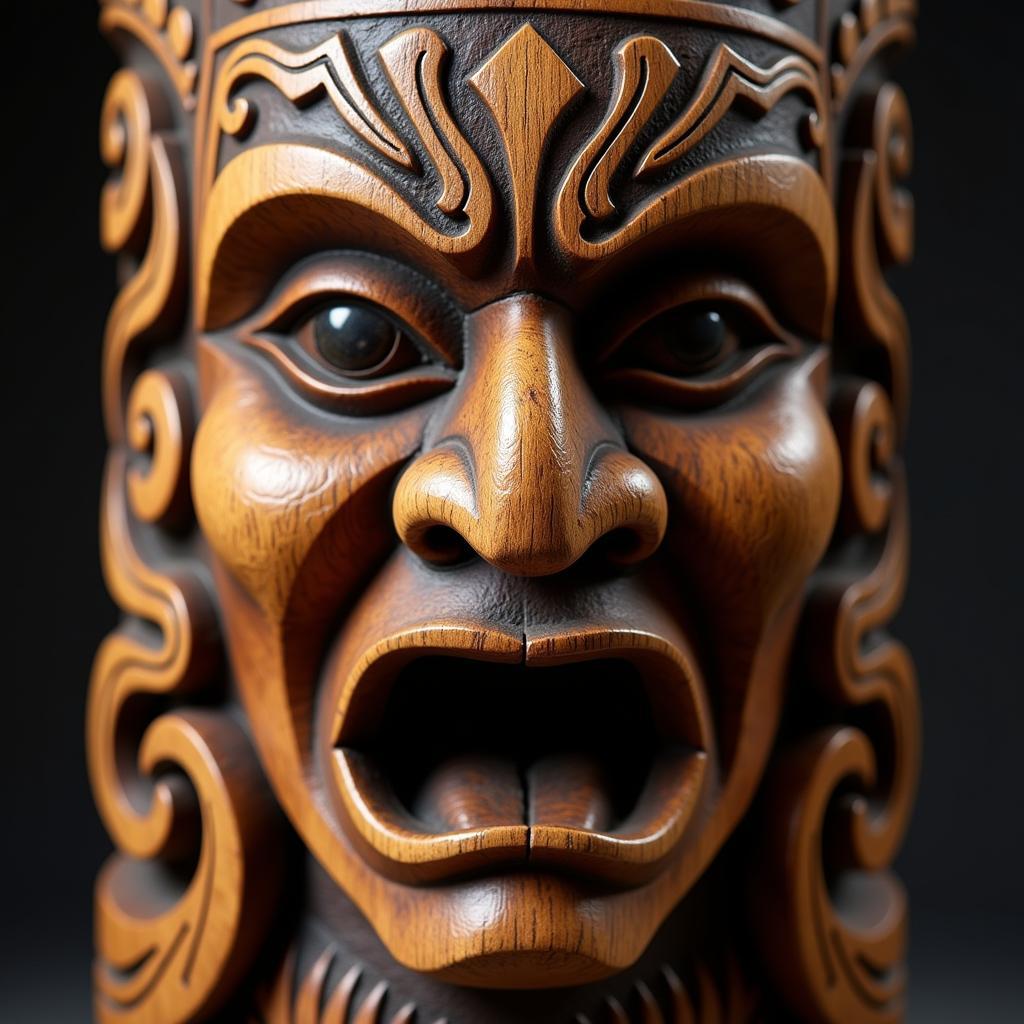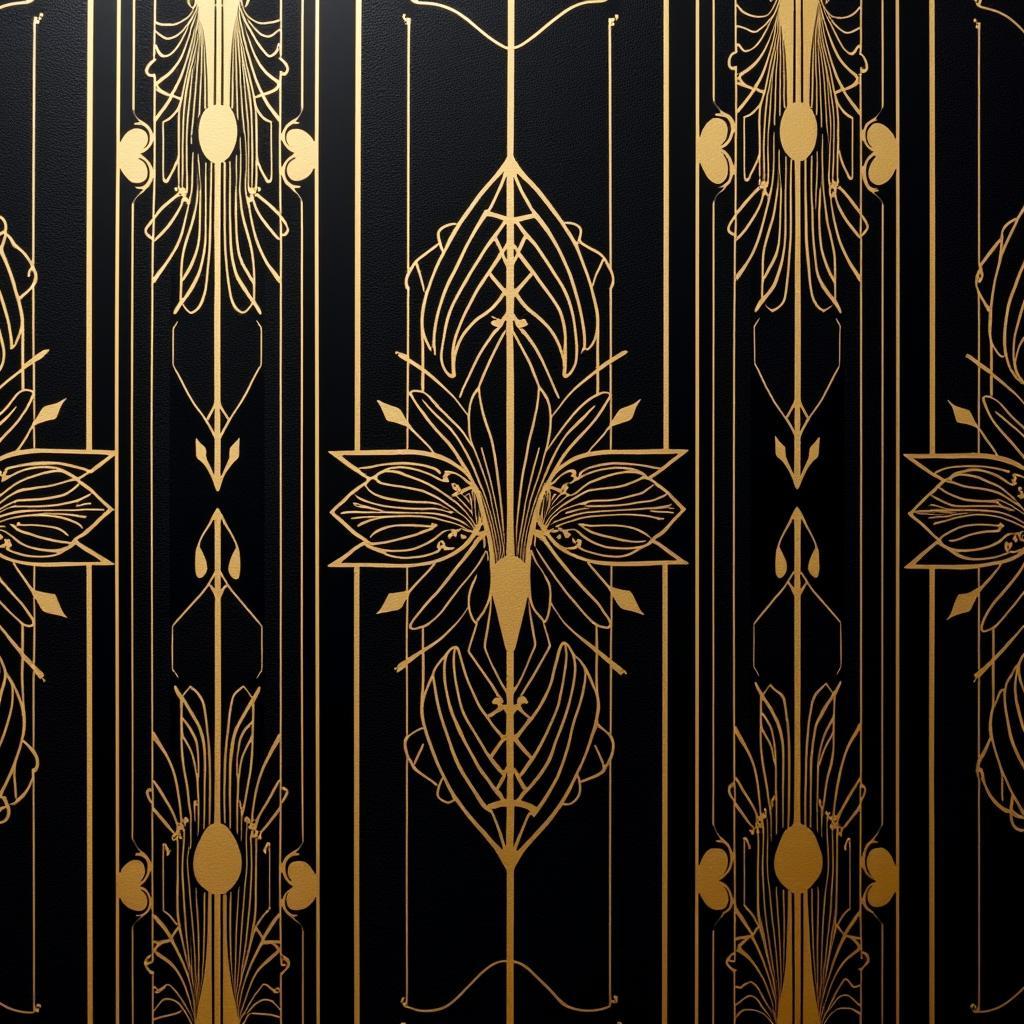Polynesian Wall Art: A Journey into Oceanic Culture and Heritage
Polynesian Wall Art offers a captivating glimpse into the rich history, vibrant culture, and spiritual beliefs of the Polynesian people. More than just decorative pieces, these artworks serve as visual narratives, preserving ancient traditions and connecting contemporary generations to their ancestral roots. From intricate carvings and woven tapestries to bold paintings and symbolic patterns, Polynesian wall art transforms spaces into immersive cultural experiences.
 Polynesian wall art in the form of a carved wooden tiki mask.
Polynesian wall art in the form of a carved wooden tiki mask.
Unveiling the Significance of Polynesian Symbols
Central to understanding Polynesian wall art is the profound meaning embedded within its recurring motifs. Each symbol holds a specific significance, often representing deities, ancestral spirits, elements of nature, or important cultural values.
- Tiki: Perhaps the most recognizable Polynesian motif, the tiki represents deified ancestors or gods, embodying strength, protection, and guidance. Tikis often feature exaggerated facial features and powerful stances.
- Honu (Sea Turtle): Revered for their longevity and navigational prowess, sea turtles symbolize perseverance, good luck, and the interconnectedness of life.
- Hei Matau (Fish Hook): Beyond its practical use, the fish hook represents prosperity, abundance, and the connection to the ocean, a vital source of sustenance for Polynesian communities.
- Enata (Human Figures): Stylized human figures often appear in Polynesian art, representing ancestors, deities, or important figures in Polynesian mythology.
Materials and Techniques: A Testament to Artistry
Polynesian artists demonstrate exceptional skill and ingenuity in their use of natural materials and traditional techniques. These artistic practices have been passed down through generations, preserving cultural heritage and ensuring the continuity of artistic traditions.
- Wood Carving: From towering tiki statues to intricately designed weapons and tools, wood carving occupies a central place in Polynesian art. Artists employ a variety of traditional tools, including chisels, adzes, and sharks’ teeth, to shape wood into expressive forms.
- Tapa Cloth: Made from the bark of the mulberry tree, tapa cloth serves as a versatile canvas for Polynesian artists. Intricate patterns are applied using natural dyes and pigments, often depicting geometric designs, mythological scenes, or symbolic motifs.
- Weaving: Using materials like pandanus leaves, coconut fibers, and feathers, Polynesian artisans create stunning woven pieces. These woven works range from mats and baskets to ceremonial garments and wall hangings, showcasing intricate patterns and vibrant colors.
Integrating Polynesian Wall Art into Your Space
Incorporating Polynesian wall art into your home is a wonderful way to infuse your living spaces with cultural richness and visual intrigue.
- Create a Focal Point: A large-scale tiki mask or a striking woven tapestry can serve as a captivating focal point in your living room, dining area, or bedroom.
- Embrace Natural Textures: The organic textures of wood carvings and woven pieces complement a variety of interior design styles, from bohemian to contemporary.
- Infuse Color Strategically: While Polynesian art often features earthy tones, don’t shy away from pieces that incorporate vibrant colors, such as red, yellow, and blue, to add pops of visual interest.
- Consider the Story: When selecting Polynesian wall art, take the time to learn about the meaning behind the symbols and motifs. This will deepen your appreciation for the artwork and allow you to share its cultural significance with others.
Preserving Cultural Legacy Through Art
“Polynesian art is more than just aesthetics; it’s a living embodiment of our history, beliefs, and connection to the natural world,” says renowned Polynesian art expert, Dr. Lani Ka’iulana. “By appreciating and sharing these artworks, we contribute to the preservation of a rich cultural heritage.”
By understanding the symbolism, appreciating the artistry, and thoughtfully integrating Polynesian wall art into your home, you can embark on a journey of cultural discovery and create a space that reflects your appreciation for the beauty and depth of Polynesian heritage.
Frequently Asked Questions
1. What are some common materials used in Polynesian wall art?
Common materials include wood, tapa cloth, feathers, shells, bone, and stone.
2. What is the significance of the color red in Polynesian culture?
Red often represents mana, or spiritual power, and is associated with royalty and high status.
3. Are there any taboos or cultural sensitivities to be aware of when displaying Polynesian wall art?
It’s important to treat Polynesian art with respect. Avoid placing tiki masks directly on the ground and research the cultural significance of pieces before displaying them.
4. Where can I find authentic Polynesian wall art?
Reputable art galleries, cultural centers, and online marketplaces specializing in Polynesian art are good places to start.
5. How can I learn more about the stories and meanings behind Polynesian symbols?
Museums, cultural institutions, and books on Polynesian art and mythology can provide valuable insights.
For further exploration of ocean-inspired art, delve into the beauty and symbolism of whale tail art.
Need help finding the perfect piece of Polynesian wall art for your home? Contact us at Phone Number: 02462573573, Email: danteum@gmail.com Or visit us at: Savico Megamall, 7-9 Đ. Nguyễn Văn Linh, Gia Thụy, Long Biên, Hà Nội 10000, Việt Nam. We have a 24/7 customer service team.





